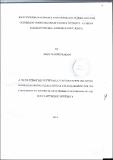Effectiveness of guidance and counseling among secondary school students: A case of Kasarani District, Nairobi county, Kenya

View/
Date
2014-06Author
Karani, Mary Wanjiru
Type
ThesisLanguage
enMetadata
Show full item recordAbstract
There is an increased death rate in Kenya which affects the society at large. Bereaved students resume school when still in grief because grieving process takes a long time. The school is an important source of social support. High school students have growth issues, and are in a period of transition from childhood to adulthood with many challenges. These challenges can be compounded when they undergo loss and grief This study examined the effectiveness of guidance and counseling in grief and loss counseling among secondary school students in Kasarani District of Nairobi County. An accessible population of 42 teacher-counselors was targeted out of which a sample of 21 participated in the study. The target population was 7648 secondary school students out of which a sample of 189 students who had lost a significant person in their life participated in the study. Pertinent data was gathered using a structured questionnaire and interview schedule. The instruments were scrutinized by my two supervisors to judge on the items appropriateness of content and to determine whether the objectives of the study would be achieved. Reliability was determined by pilot testing of the instruments. Test¬-retest procedure was used and a reliability coefficient of 0.82 obtained. Questionnaires were administered by the teacher- counselors in the presence of the researcher and collected the same day after completion. Data was edited, coded and then subjected to analysis using Statistical Package for Social Sciences (SPSS) computer software. Both quantitative and qualitative methods were used in the analysis. Consequently, descriptive and inferential statistics were made use of Percentages and frequency graphs as well as charts were used to present the results. William Worden theory of counseling was used which views moaning as necessary and sees counseling as a facilitative process that allows the bereaved to move on with life without the deceased. The findings showed that although students sought grief and loss counseling and schools supported the grieved students, they perceived grief and loss counseling ineffective. Grief and loss training among the teacher-counselors was also inadequate. It was recommended that teacher¬-counselors should educate students about the process of grieving. The teacher-counselors should be given more training in grief and loss to make them more effective in helping bereaved students. Support centres for students should be maintained and ¬bereavement counseling should be given to students.
Publisher
KeMU
